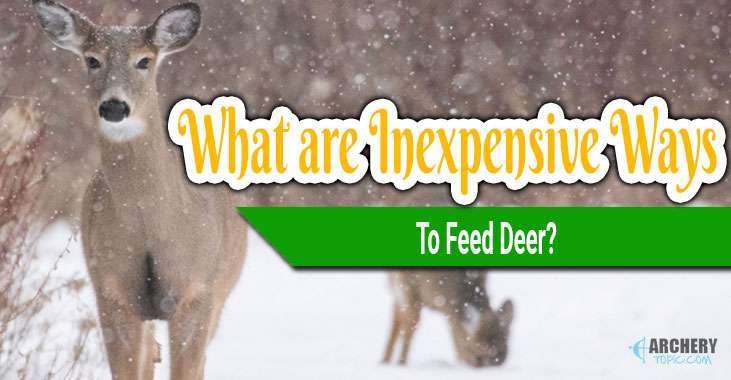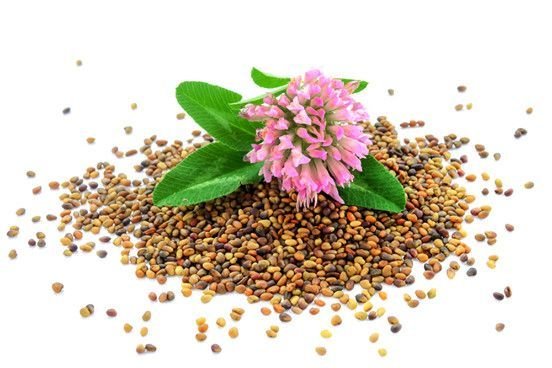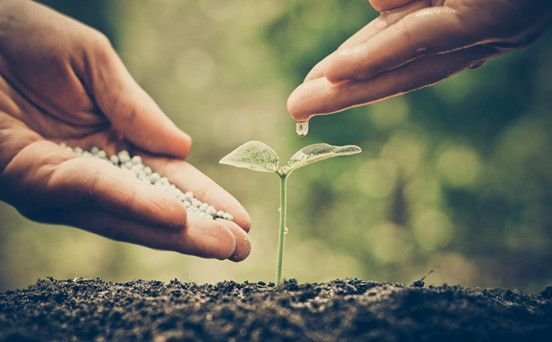If you're wondering:
You'll know the answers and attract more and more deer below. Check it out:

1. Clover Seeds:

Ultimately, deer feed best in the wild outdoors, consuming mother nature’s splendor. Ideally, they would be roaming free, munching on wild soybeans or farm corn.
But if you are attempting to keep them in a particular, enclosed area and they can’t simply wander where they please, then planting clover seeds on your land - or the land they are being kept in.
This is a very cheap way of making sure there is always something for them to eat.
Buy bulk bags
You can buy bulk bags of clover seeds from most plant stores and seed distributors, in sizes up to five kilograms and more.
So, if you know this is something that works for you and the local deer, it is worth buying in bulk.
Free trial packs
However, if you are not sure, you can attend regular gardening shows and the likes, where you will find that often, free trial packs are on offer.
This is a great way of planting them and waiting to see if it produces the results you are after.
How to use:
You do not need any hi-tech or advanced machinery to do the seed planting. Simply pick the areas you wish to lure the deer too and sprinkle the seeds around by hand.
The best part?
It is not, in most states, considered to be baiting and so is within legal boundaries.
2. Relocate Fallen Fruit:

This is not just an inexpensive way of feeding deer if executed properly - it is entirely free. All it takes is a bit of commitment, ground-work, and planning.
Deer love fruit, but going to the local supermarket to stock up during hunting season is not a financially realistic route.
Usually, deer populations keep to farm and open areas, so you are likely surrounded by fruit trees and bushes when you are seeking them out.
How to:
If you are aware that the area is low in fruit trees and bushes, it is well within your interest to consider planting a variety of them.
Though this may be costly originally, the fruit it continues to bear will be free thereafter.
It could even be worth collaborating with fellow hunters in the community, who hunt in similar areas - this way, everyone benefits.
3. Collect and Freeze Nuts:

Though similar in theory to the fruit relocation method, collecting nuts is just as inexpensive but far easier to pre-prepare and less time-consuming.
As can be imagined, the fruit relocation is required on a need’s basis, meaning that you would need to collect the fallen produce on the day or the day before your hunt.
Rotten fruit is not on the deer’s preferred menu. Nuts keep well, can be frozen and can remain in a large container to be accessed whenever they are running low.
Deer feed enthusiastically on nuts and acorns, which don’t rot or attract insects at the same frequency as fruit, if at all.
How to:
Make it pre-season activity one weekend and you will be sorted for the season.
If everyone collects fallen acorns, walnuts, and pecans from trees, you can keep the stash at home and sprinkle them in the desired area whenever you need to.
Nuts of all varieties are usually OK for deer, but corn should be avoided at all costs as it makes them sick.
The best trick of the trade when it comes to acorns is if you have collected an excess, is that you can freeze and use them next season!
4. Maintain the Area:

Contrary to popular belief, you should not just let deer-dense areas run wild and unkempt.
Yes, it is true that deer feed best from foliage and the natural growth of the countryside.
But this is not to say that you can’t keep the area ripe for growth.
An overgrown area does not reap the benefits of fruit in the same way as a pruned tree that has received the right nutrients does.
It also makes it harder for the deer to explore and find food for themselves. Find a balance between allowing the area to grow naturally, yet simultaneously helping it along.
This maintenance can be almost completely free once you have invested in core gardening equipment such as a chainsaw, a lawnmower, and an axe.
Note:
It is advised that you enquire with the local authorities about which outdoor elements are to be protected.
Because this method is hardly a cheaper alternative if you find yourself fined for cutting down a historically relevant tree, or a privately owned one.
Contained fires, nutritional spraying, mowing, fertilizing and chopping overgrowth are all prime examples of how to ensure the plants can grow to their full potential and increases their likelihood of fruiting.
5. Make Homemade Deer Feed:

Bags of deer food are easy to come by. Unfortunately, they are not the most cost-effective way to feed deer, especially when you consider that deer are best off eating natural foods.
Here are simple ingredients that you can mix to make your own deer food that is inexpensive and available in bulk at most supermarkets.
Suitable ingredients include:
All of these ingredients can be grown in your garden, so if you are planning on hunting for a long time, then the most cost-effective route would be to grow your own.
Pro tips:
This is another great way to collaborate with fellow deer enthusiasts in the local area.
If everyone were to grow something useful and consumable for deer, then you can exchange and work together to feed them.
Note:
It is important to remember, though, that a deer needs to adjust to human foo
So only provide it in small doses for two to three weeks before spreading it as freely as you would other deer-appropriate food.
Once the deer is comfortable, you can use a gelling agent like molasses to turn it into a big block that the deer can slowly nibble from.
6. Peanut Butter:

Considering deers’ affection for nuts and sugar, it should come as no surprise that peanut butter is a big hit amongst the deer community!
Note:
Naturally, most peanut butter, especially those of a cheaper variety that come in big, affordable containers, are not purely nuts.
Rather, they are packed with complex carbohydrates, fats and other additives that are not great for deer digestive systems and can lead them to have an unhealthy dependency on unnatural foods.
This could, in turn, make them harder to feed, which goes against your original intention.
However, the following technique does not require them to eat very much peanut butter at all, it simply requires them to be drawn in by the smell of it.
How to:
Ideally, a lick is about as much of the sweet treat that they will be able to get.
Cut out a small hole or gash in the bottom of a tub of peanut butter and hang it from a tree in an area where you would like to attract deer.
They will smell and be heavily distracted by the contraption, which you should aim to have to hang roughly 4-5 feet from the ground so that they don’t simply break the tub.
7. Salt Water:

It can often come as a surprise to hear, but saltwater really pleases deer. It is like the cat-nip of the deer world.
While it is not necessarily the best way to feed them, as it has almost no nutrients and will dehydrate them somewhat, it is a good way to attract them to an area.
Once you have done that, you can leave other foods, as listed previously, to feed them. Mixing salt water and nuts, for instance, is a great combination.
Feeding deer can be more than just providing food, it is also important to get them in the right place to eat it. This is one of those ways and is cheap and easy.
What you are ultimately doing with this technique is getting the deer to the food and leading them to spots where they can enjoy.
More than that, though - they really enjoy it! It is not some complex salt that you have not heard of before, but rather your regular kitchen salt which most will know is easy to find in bulk at local supermarkets.
In towns that are snow prone, it is extra simple to find as enormous bags are sold in home stores to grit the road.
Simply dissolve this in some warm water and you have yourself a deer-attractor.
Conclusion:
These are 7 inexpensive ways to feed deer, which are not time-consuming and definitely cheap.
The major thing it requires is a bit of foresight and a willingness to put some effort into the collection.
If you take away one thing from these tips, it is that it is all about collaboration, community and sharing tips.
Do share in the comments below.
